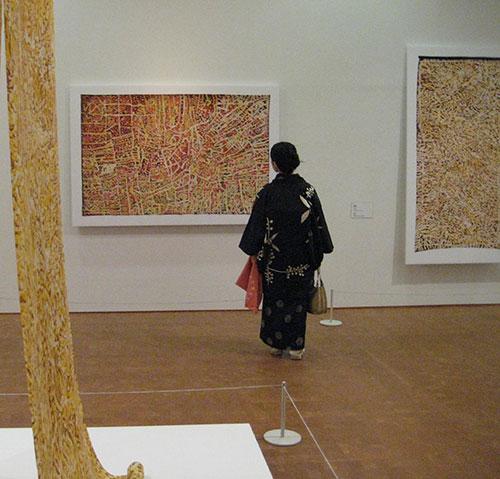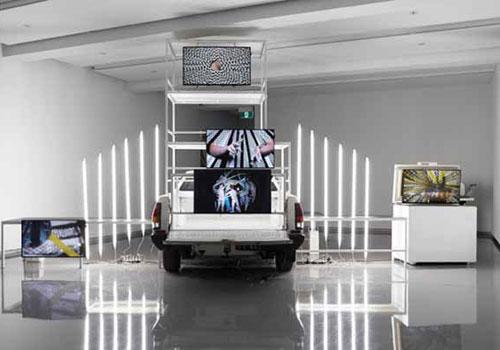My name is Chantelle Woods; I am a Worimi woman. My country lies in and around Port Stephens and the Great Lakes area of northern NSW, but I was born in Katoomba in the Blue Mountains. My family now live scattered throughout NSW and it wasn’t until my grandmother’s 60th birthday ten years ago that we were all reunited. As a curator and an Aboriginal woman I have immensely enjoyed the privilege of providing an indigenous perspective within a realm that is so culturally important to me; Aboriginal art is a form of storytelling and of recording our history. Since 2003, I have been fortunate to work with some of the country’s premier art institutions and collections, but also have had the opportunity to work in remote Aboriginal communities. My knowledge base is therefore eclectic and my experiences first-hand.
When I was offered the opportunity to work with Djon Mundine and Daniel Browning on the next issue of Artlink Indigenous I jumped at the chance.
The role of an assistant or intern involves the usual tasks of researching, running around, collating and finalising details and chasing people up, as the typical gofer. But these seemingly mundane jobs play an important role in any organisation. It’s also the place that you really get to learn the ins and outs of how something, like a journal, is compiled. Having the time and space to really absorb the undercurrent of information and themes, I’ve learnt a lot.
Artlink has sentimental value for me; it was the first place to publish one of my articles outside the institutions and galleries I‘d worked in. Djon, who was also working at the Queensland Art Gallery at the time, encouraged me to write about my experiences while living and working within the remote Aboriginal community of Lockhart River on the eastern peninsula of Cape York in Far North Queensland. I moved from mainstream society into a remote land, a place half lost in time, half out of sight. It was here that I began to really explore my own identity and understand where I was coming from.
At the time, I had been part of an initiative run by the Queensland Art Gallery to undertake a traineeship while working on an Indigenous exhibition highlighting Cape York’s historic and contemporary artistic output. Since then, I have worked at the National Gallery of Australia and the Biennale of Sydney on the 19th exhibition You Imagine What You Desire as the Aboriginal Curatorial Fellow. This position turned just about everything I’d learned about curating on its head. As an arts festival it was logistically larger than anything I’d worked on, not being restricted to the white cube or the solid sandstone gallery space. It also provided me with my first real opportunity to work with international artists, including Aboriginal artists from other countries and nations. It was also the first time that I had the experience of being an ‘outsider’.
As a curator, the importance of an Indigenous perspective on Indigenous art is central to my practice, as experienced through my work with communities and institutions, also through my work on the National Indigenous Art Triennial and the Stage One roll-out of the Indigenous galleries at the National Gallery of Australia. All these roles, have helped me to create an identity through my work.
I also recently made my artistic debut in the 2015 exhibition Bungaree’s Farm, an ongoing project curated by Djon Mundine with Mosman Art Gallery in Sydney. My mother, Sandy Woods and I were asked to sing a Biripi woman’s lament song that was first recorded around 1830. This was the first time my mother and I had spoken our language. It was a special and grounding experience of connecting with each other and our culture together.
Next week I am off to Venice to participate in the 56th Venice Biennale All the World’s Futures as part of the Professional Development Program for Emerging Curators run by the Australia Council. It’s an exciting year for Australia at the Biennale as they set to unveil the new Australian Pavilion while highlighting the incredible oeuvre of Fiona Hall with Wrong Way Time. This year it also marks a milestone with the number of additional Australian artists selected to participate in the collateral exhibitions, mostly chosen by the Artistic Director Okwui Enwezor. Tjanpi weavers from the APY lands of central Australia were part of a collaborative project with Fiona Hall and some of them will be making the long trip over there. Daniel Boyd, Michael Cook, Reko Rennie and the late Emily Kame Kngwarreye are just some of the artists that will also be exhibiting there. The Venice Biennale will highlight one of the biggest crosscultural exchanges in the art world through providing a platform to encourage and inform people to think, feel and act through art and material while commenting on the precarious state of things happening globally today, and as a result of history.












